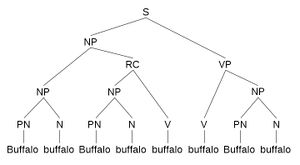User:Simon/Affirmative Generator: Difference between revisions
No edit summary |
No edit summary |
||
| Line 3: | Line 3: | ||
Based on the power of having P.M.A (Positive Mental Attitude), the Affirmative Generator (AF) makes affirmations to print and display in the work space. Its use is not limited to this space, but this is taken as a departure point for testing. The AF borrows from a selection of words within a limited syntax and creates new meanings in the process. | Based on the power of having P.M.A (Positive Mental Attitude), the Affirmative Generator (AF) makes affirmations to print and display in the work space. Its use is not limited to this space, but this is taken as a departure point for testing. The AF borrows from a selection of words within a limited syntax and creates new meanings in the process. | ||
== | ==Ambiguity== | ||
Inspiration comes from ideas of ''syntactic ambiguity'' and "lexical ambiguity", which areas of linguistic study interested in sentences that may be read in several different ways due to the ambiguity of their components meaning (lexical) and also the way they are constructed in a sentence (syntax). A fluent speaker of a language parses the components of an utterance, often adding contextually implied meanings that may be common in their vernacular. | |||
===Buffalo buffalo Buffalo buffalo buffalo buffalo Buffalo buffalo=== | ===Buffalo buffalo Buffalo buffalo buffalo buffalo Buffalo buffalo=== | ||
An example of this is the "Buffalo buffalo Buffalo buffalo buffalo buffalo Buffalo buffalo" sentence, first appearing in 1967 in [https://en.wikipedia.org/wiki/Beyond_Language ''Beyond Language: Adventures in Word and Thought''] by [https://en.wikipedia.org/wiki/Dmitri_Borgmann Dmitri Borgmann]. | An example of this is the "Buffalo buffalo Buffalo buffalo buffalo buffalo Buffalo buffalo" sentence, first appearing in 1967 in [https://en.wikipedia.org/wiki/Beyond_Language ''Beyond Language: Adventures in Word and Thought''] by [https://en.wikipedia.org/wiki/Dmitri_Borgmann Dmitri Borgmann]. This type of sentence (as well as many other examples) introduce the idea of syntactic ambiguity - by which a sentence may be interpreted in more than one way due to its ambiguity. | ||
[[File:Buffalo sentence 1 parse tree.jpg|thumbnail]] | [[File:Buffalo sentence 1 parse tree.jpg|thumbnail]] | ||
Revision as of 22:58, 15 October 2018
Affirmative Generator
Based on the power of having P.M.A (Positive Mental Attitude), the Affirmative Generator (AF) makes affirmations to print and display in the work space. Its use is not limited to this space, but this is taken as a departure point for testing. The AF borrows from a selection of words within a limited syntax and creates new meanings in the process.
Ambiguity
Inspiration comes from ideas of syntactic ambiguity and "lexical ambiguity", which areas of linguistic study interested in sentences that may be read in several different ways due to the ambiguity of their components meaning (lexical) and also the way they are constructed in a sentence (syntax). A fluent speaker of a language parses the components of an utterance, often adding contextually implied meanings that may be common in their vernacular.
Buffalo buffalo Buffalo buffalo buffalo buffalo Buffalo buffalo
An example of this is the "Buffalo buffalo Buffalo buffalo buffalo buffalo Buffalo buffalo" sentence, first appearing in 1967 in Beyond Language: Adventures in Word and Thought by Dmitri Borgmann. This type of sentence (as well as many other examples) introduce the idea of syntactic ambiguity - by which a sentence may be interpreted in more than one way due to its ambiguity.
This particular sentence uses the word "buffalo" as 3 discrete components:
1. A proper noun (meaning the city of Buffalo in upstate New York).
2. A verb (meaning to bully - an uncommon spoken use, but familiar to North American English speakers)
3. A common noun (meaning a kind of bison indigenous to certain parts of North America)
So the sentence can be read as:
Buffalo buffalo (Buffalo that are from the town of Buffalo)
Buffalo buffalo (that other buffalo from Buffalo) buffalo (bully)
[themselves] buffalo (bully)
Buffalo buffalo (buffalo from Buffalo)

